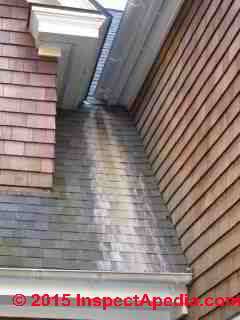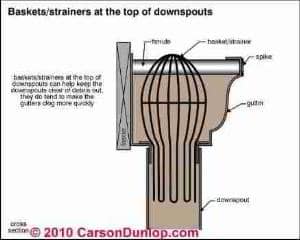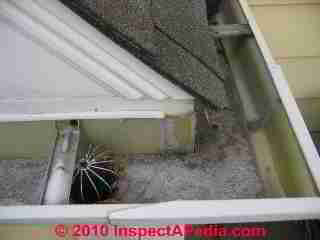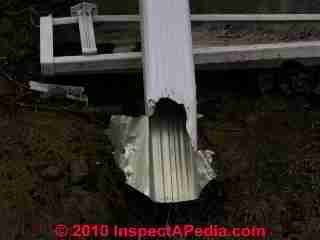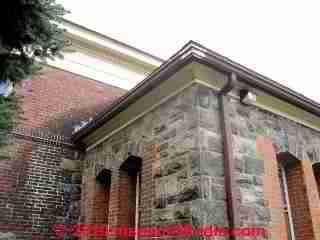 Roof Gutter Downspout Mistakes, Leaks, Problems
Roof Gutter Downspout Mistakes, Leaks, Problems
- POST a QUESTION or COMMENT about downspout leaks, repairs, installation, maintenance
Common mistakes in roof leader or downspout systems causing leaks & damage:
This article describes defects in roof leaders or downspout systems such as inadequate number of downspouts to handle the volume of roof drainage, missing, lost, or damaged downspouts.
This article series discusses how to choose, install, diagnose & maintain roof gutters & downspouts, & roof drainage systems to prevent building leaks and water entry.
InspectAPedia tolerates no conflicts of interest. We have no relationship with advertisers, products, or services discussed at this website.
- Daniel Friedman, Publisher/Editor/Author - See WHO ARE WE?
More Downspout Defects & Downspout Installation Details and Mistakes
Missing gutter and/or downspout on upper or secondary roofs
Above our photo of an upper roof with no gutter (below left) shows how seriously water splash-up may stain or affect building walls. Not shown (not visible) in that photo is wear on the roof shingles from water splashing from above.
Our photo below shows algae growth on shingles from a downspout spilling across roof shingles.
[Click to enlarge any image]
We often see early roof shingle wear, staining, or even roof leaks on lower roof slopes in areas where drainage from an upper or secondary roof slope spills onto the lower roof slope.
Sketches in this section courtesy of Carson Dunlop Associates, a Toronto home inspection, education & report writing tool company [ carsondunlop.com ].
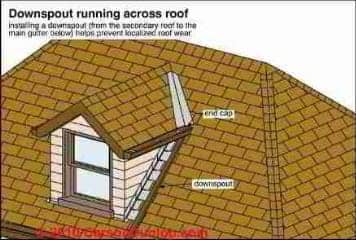
A solution to the wear problem caused by spillage from upper roof slopes onto lower roof slopes is the installation of gutters on the upper roof slope combined with a downspout to conduct that upper gutter's drainage contents directly into a lower roof gutter or even directly to the ground.
As Carson Dunlop Associates' sketch illustrates, if a small auxiliary roof extends far enough from the building foundation wall you might get away with a simple elbow that spills onto a splash block rather than a full downspout and extension installation.
Watch out: in the illustration shown if the splash block does not conduct water far enough away from that basement walkout stairwell water may cause damage to the stairwell sides.
Especially in freezing climates we often see frost heaves and collapsing concrete block stairwells that have been exposed to main roof or small auxiliary roof water runoff.
Sketches used here are provided courtesy of Carson Dunlop Associates, a Toronto home inspection, education & report writing tool company [ carsondunlop.com ].
Number of Downspouts Needed

As we've stated earlier, a rule of thumb is to install a downspout for every 35-40 feet of length of gutter. But there are some other considerations to keep in mind.
If the roof design prevents good gutter slope (less than 1" of gutter drop in 200" of run) then adding more downspouts can help prevent gutter overflow in periods of heavy rain.
Adding more downspouts (and larger gutters) can reduce the frequency of gutter overflow due to clogging on roof slopes close to trees, especially pines and firs whose smaller needles wash into and clog gutters and screened gutters.
More downspouts will be needed for discontinuous runs of gutters along irregular roof eaves or slopes.
Sketch courtesy of Carson Dunlop Associates, a Toronto home inspection, education & report writing tool company [ carsondunlop.com ].
Advice about Gutter & Downspout Strainers
Use of strainers both helps and hurts with the downspout and gutter clog and overflow problem.
Installing a strainer in the gutter where it empties into a downspout helps keep the downspouts clear of debris and clogs. As Carson Dunlop point out, the gutter itself will clog more quickly with a strainer installed however.
Watch out: if your downspout system includes buried lines, clearing a clogged buried drain line can be difficult and expensive. For buried drain line systems we recommend that you always keep strainers installed at the downspouts at the gutter drain points.
[Click any image or sketch to see an enlarged, detailed version.]
It's usually easier to clean the gutter than to clean the buried downspout drain line. Sketch courtesy of Carson Dunlop Associates, a Toronto home inspection, education & report writing tool company [ carsondunlop.com ].
Animal Damage to Downspouts - Dog Bites Downspout?
Our photos below show unusual downspout extension damage - doesn't it look as if something has "chewed" the aluminum downspout ends? in fact that was just the case. The building owner explained that when a squirrel or other rodent entered the downspout the family dog became quite excited by the animal's noise or odor even though the humans were unaware of their visitor.
The dog, frantic to get to the now trapped animal, tore up the downspouts with its bare teeth. The second downspout dog bite photo (below right) was the same phenomenon observed at a different property. More than one dog with strong jaws finds downspouts interesting.
Another bad dog chewing damage example is
...
Continue reading at DRYWELLS, FRENCH DRAINS for FLAT SITES or select a topic from the closely-related articles below, or see the complete ARTICLE INDEX.
Or see these
Recommended Articles
- GUTTERS & DOWNSPOUTS - home
- DOWNSPOUT / LEADER DEFECTS
- DOWNSPOUTS BURIED / BELOW GRADE
- ABANDON BURIED DOWNSPOUTS
- CLOGGED BURIED DOWNSPOUTS
- CONNECT DOWNSPOUTS to BUILDING DRAINS?
- PERFORATED PIPE DOWNSPOUT DRAINS
- BURIED ALUMINUM DOWNSPOUTS
- UNDER-SIZED DOWNSPOUT DRAINS
- SHARED DOWNSPOUT DRAINS
- DOWNSPOUT EXTENSIONS
- DOWNSPOUT ONTO BACKFILL
- DOWNSPOUT ONTO IN-SLOPE GRADE
- DOWNSPOUT LEAKS
- DOWNSPOUT DEFECTS, OTHER
Suggested citation for this web page
DOWNSPOUT DEFECTS, OTHER at InspectApedia.com - online encyclopedia of building & environmental inspection, testing, diagnosis, repair, & problem prevention advice.
INDEX to RELATED ARTICLES: ARTICLE INDEX to GUTTERS & DOWNSPOUTS
Or use the SEARCH BOX found below to Ask a Question or Search InspectApedia
Ask a Question or Search InspectApedia
Questions & answers or comments about downspout leaks, repairs, installation, maintenance.
Try the search box just below, or if you prefer, post a question or comment in the Comments box below and we will respond promptly.
Search the InspectApedia website
Note: appearance of your Comment below may be delayed: if your comment contains an image, photograph, web link, or text that looks to the software as if it might be a web link, your posting will appear after it has been approved by a moderator. Apologies for the delay.
Only one image can be added per comment but you can post as many comments, and therefore images, as you like.
You will not receive a notification when a response to your question has been posted.
Please bookmark this page to make it easy for you to check back for our response.
IF above you see "Comment Form is loading comments..." then COMMENT BOX - countable.ca / bawkbox.com IS NOT WORKING.
In any case you are welcome to send an email directly to us at InspectApedia.com at editor@inspectApedia.com
We'll reply to you directly. Please help us help you by noting, in your email, the URL of the InspectApedia page where you wanted to comment.
Citations & References
In addition to any citations in the article above, a full list is available on request.
- Mark Cramer Inspection Services Mark Cramer, Tampa Florida, Mr. Cramer is a past president of ASHI, the American Society of Home Inspectors and is a Florida home inspector and home inspection educator. Mr. Cramer serves on the ASHI Home Inspection Standards. Contact Mark Cramer at: 727-595-4211 mark@BestTampaInspector.com
- John Cranor [Website: /www.house-whisperer.com ] is an ASHI member and a home inspector (The House Whisperer) is located in Glen Allen, VA 23060. He is also a contributor to InspectApedia.com in several technical areas such as plumbing and appliances (dryer vents). Contact Mr. Cranor at 804-873-8534 or by Email: johncranor@verizon.net
- In addition to citations & references found in this article, see the research citations given at the end of the related articles found at our suggested
CONTINUE READING or RECOMMENDED ARTICLES.
- Carson, Dunlop & Associates Ltd., 120 Carlton Street Suite 407, Toronto ON M5A 4K2. Tel: (416) 964-9415 1-800-268-7070 Email: info@carsondunlop.com. Alan Carson is a past president of ASHI, the American Society of Home Inspectors.
Thanks to Alan Carson and Bob Dunlop, for permission for InspectAPedia to use text excerpts from The HOME REFERENCE BOOK - the Encyclopedia of Homes and to use illustrations from The ILLUSTRATED HOME .
Carson Dunlop Associates provides extensive home inspection education and report writing material. In gratitude we provide links to tsome Carson Dunlop Associates products and services.



